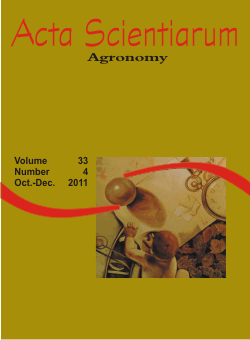<b>Gas exchange of potted <em>Tabebuia aurea</em> plants under hydric stress</b> - doi: 10.4025/actasciagron.v33i4.11254
Keywords:
hydric deficit, photosynthesis, conductance, Tabebuia
Abstract
To evaluate the effects of hydric stress on CO2 and H2O exchange, five-month-old Tabebuia aurea seedlings cultivated in planting bags were subjected to hydric stress by suppressing irrigation for 21 days. After 14 days without irrigation, the rates of transpiration, stomatal conductance and net photosynthesis in leaves were zero, while the hydric potential of leaves reached -2.4 MPa. After this point, daily irrigation was resumed, and the values of the measured variables recovered to initial levels after 96 hours (transpiration rate from 3.2 to 3.5 mmol m-2 s-1; stomatal conductance rate from 0.32 to 0.35 mol m-2 s-1 and photosynthesis rate from 8.0 to 9.8 µmol m-2 s-1). Likewise, hydric potential values were similar to those at the beginning of the experiment (-0.6 MPa). These results demonstrate that T. aurea has mechanisms to tolerate a period of hydric deficit, which may be considered ecologically relevant.Downloads
Download data is not yet available.
Published
2011-05-04
How to Cite
Oliveira, A. K. M., Gualtieri, S. C. J. de, & Bocchese, R. A. (2011). <b>Gas exchange of potted <em>Tabebuia aurea</em> plants under hydric stress</b> - doi: 10.4025/actasciagron.v33i4.11254. Acta Scientiarum. Agronomy, 33(4), 641-647. https://doi.org/10.4025/actasciagron.v33i4.11254
Issue
Section
Crop Production
DECLARATION OF ORIGINALITY AND COPYRIGHTS
I Declare that current article is original and has not been submitted for publication, in part or in whole, to any other national or international journal.
The copyrights belong exclusively to the authors. Published content is licensed under Creative Commons Attribution 4.0 (CC BY 4.0) guidelines, which allows sharing (copy and distribution of the material in any medium or format) and adaptation (remix, transform, and build upon the material) for any purpose, even commercially, under the terms of attribution.
2.0
2019CiteScore
60th percentile
Powered by 

2.0
2019CiteScore
60th percentile
Powered by 



















































